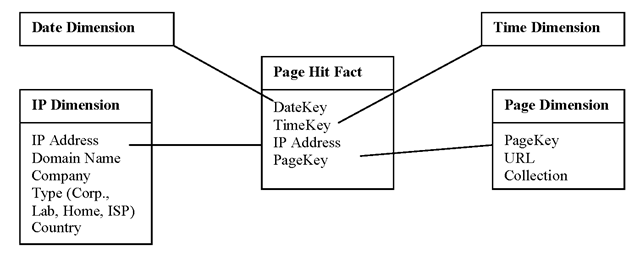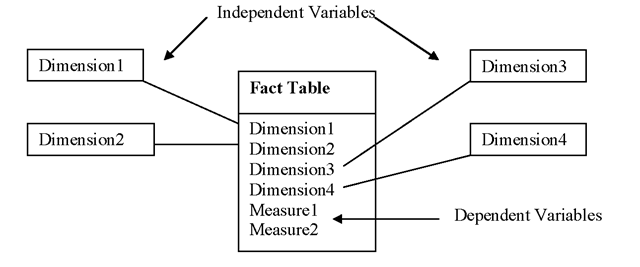INTRODUCTION
Data warehousing is an emerging technology that greatly extends the capabilities of relational databases specifically in the analysis of very large sets of time-oriented data. The emergence of data warehousing has been somewhat eclipsed over the past decade by the simultaneous emergence of Web technologies. However, Web technologies and data warehousing have some natural synergies that are not immediately obvious. First, Web technologies make data warehouse data more easily available to a much wider variety of users. Second, data warehouse technologies can be used to analyze traffic to a Web site in order to gain a much better understanding of the visitors to the Web site. It is this second synergy that is the focus of this article.
DATA WAREHOUSE
A data warehouse is a repository of nonvolatile temporal data used in the analysis and tracking of key business processes. Temporal or time varying is the most important characteristic that distinguishes a data warehouse from a traditional relational database, which represents the state of an organization at a point in time. A relational database is a snapshot of the organization, whereas the data warehouse is a collection of longitudinal data.
One could argue that it should be possible to store longitudinal data in a relational database, and this claim is true. However, relational databases, which model data as entities, create sever limitations in data exploitation.
First, although standard SQL does provide a DateTime data type, it is very limited in its handling of dates and times. If an analyst wanted to compare summary data on weekends versus weekdays or holidays versus non-holidays, it would be difficult if not impossible using standard SQL. Second, analysis involving drill down or roll up operations becomes extremely awkward using standard SQL against entities as represented in relational tables.
Data warehousing technology overcomes these deficiencies in the relational model by representing data in a dimensional model. A dimensional model consists of a fact table (see Figure 1) and the associated dimensions. The fact table contains measures of the business process being tracked and the dimensional tables contain information on factors that may influence those measures. More specifically, the fact table contains dependent variables while the dimension tables contain independent variables. Online analytical processing (OLAP) tools provide a means of summarizing the measures in the fact table according to the dimensions provided in the dimension table toward the end of determining what factors influence the business process being modeled. Typically OLAP tools provide a means of easily producing higher levels of summary (roll-up) or greater levels of detail (drill-down).
WEB LOG
A visitor to a Web site requests a page by typing in the address of the page in a Web browser, or by clicking on a link that automatically requests that page. A message is sent to the Web server, at that address, and the Web server responds by returning the page. Each request that is processed by the Web server is recorded in a file called the Web log, which contains a record of all activity on the Web site. The record typically contains the date and time, the IP address of the requestor, the page requested and the result. A typical record in standard format is shown in Figure 2.
Figure 1. A dimensional model
Figure 2. A typical Web log record

From this simple log record we can determine quite a bit about the traffic coming to the Web site. For example, we can determine peak times for visitors by date or time and we can determine if Web site usage is cyclical or has other temporal patterns. Further, we can determine which pages or collections are most heavily visited and if their usage also reflects a temporal pattern. Answers to these questions are useful for site management and maintenance and for determining the effectiveness of design decisions or the behavior of the visitors to the site.
SYNERGY
A lot of valuable information can be derived from the Web log. But that is only the beginning. By viewing the Web log as a data source for a data warehouse, it becomes an even richer source of information about the Web site and its visitors. Consider the dimensional model in Figure 3. From this we can derive relationships between visitors and the pages they visit. Web log records can be summarized to produce dwell time (the time a visitor spends viewing a page) and visit length (the time a visitor spends at the site). Further, if the site is used for sales, the IP dimension can be converted to a customer dimension and the page dimension can be converted into a product dimension allowing analysis of customer purchasing behavior. For a more in depth examination of the process of evolving a Web log into a customer data warehouse, see From Web Log to Data Warehouse: An Evolving Example, listed in the references.
FUTURE TRENDS
According to information navigators, there are approximately 72 million hosts on the Web. Many of these hosts do not support Web sites, but many others (such as those owned by ISPs) have multiple Web sites. If only 10 million of these Web sites attract as few as 100 visitors a minute, then 1 billion records are generated every minute. This becomes 60 billion records per hour, or 1.4 trillion records per day. This is an enormous amount of information providing great insight into the behavior of consumers and information seekers, among others. This huge volume of temporal data cannot be exploited effectively without data warehouse technology. Hence, the growth of the Web may well push the growth of data warehousing.
At the same time, data warehousing concepts continue to evolve and the technology continues to improve.
Figure 3. A dimensional model based on the Web log

OLAP tools are making it easier to analyze dimensional data through visual interfaces and data mining tools are making it easier to find useful patterns in large volumes of data. In today’s tools there are gaps between SQL and OLAP, and again between OLAP and data mining. These disparate approaches will eventually become integrated in seamless tool sets that provide a variety of analytical techniques along with some guidance on which approaches to use.
The collection and analysis of all these data is, in many ways, a double-edged sword. From a productivity perspective, making white-collar workers more productive is clearly a good thing. However, measuring and monitoring have a very dark downside. There has been much concern since the industrial revolution that the mechanization of manufacturing could lead to undesirable working conditions for factory workers. Similarly, the mechanization of white-collar work could have similar impacts.
Further, the amassing of huge amounts of personal information is a sword that swings both ways also. On the positive side, understanding our needs allows product producers to meet those needs more fully. When you go to a shopping Web site you are often prompted with teasers that say “If you liked product X you should try product Y”. If product Y is something that you think you might want, this is good. However, many people feel that the collection of such large amounts of personal data could have serious implications for personal privacy. Indeed, it may. It all depends on how the data are used and on how that use is perceived.
CONCLUSION
Data warehousing technologies and Web technologies are highly synergistic. Web technologies make data warehouse data more accessible to a much wider variety of users on both the Internet and the Intranet. Since the value of data is determined by their usefulness in supporting decision-making, Web technologies help increase the value of the data in the warehouse. Perhaps, more importantly, as shown in this article, data warehouse technologies can be used to analyze the enormous volumes of data generated by a Web site. As Web sites generate large volumes of data for data warehouses and in turn provide easy access to those data, it is conceivable that these two highly synergistic technologies may become indistinguishable in the future.
KEY TERMS
Data Mining: The use of computer algorithms to discover relationships between data items than are hidden in the complexity of the data.
Data Warehouse: A repository of nonvolatile temporal data used in the analysis and tracking of key business processes.
Dimensional Model: A data model that represents measures of a key business process in the form of facts and the independent variables that affect those measurements.
Key Business Process: A collection of intentional business activities that is both measurable and worthy of improvement or optimization.
OLAP: On Line Analytical Process usually distinguished from On Line Transaction Processing, which is the model associated with transaction-oriented databases.
Temporal Data: Time oriented data.
Web Log: A file in which a Web server records requests for pages.

